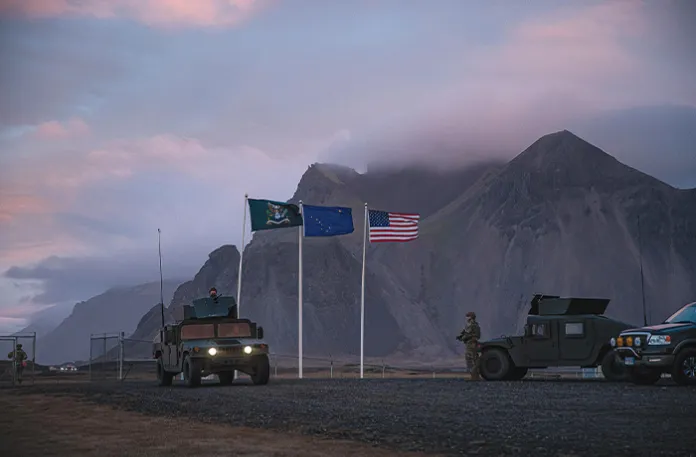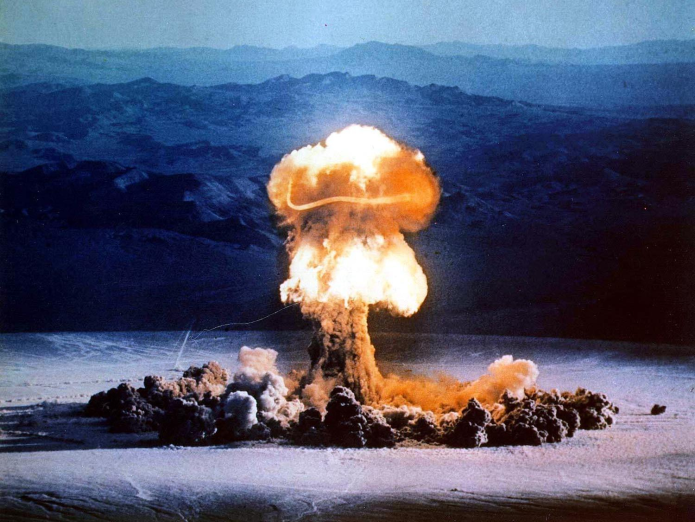The new Netflix movie A House of Dynamite, a fictional imagining of a 20-minute window between the launch of an ICBM and its effect on Chicago, was meant to be a conversation starter.
And on that score, it landed a direct hit.
Upon its release two months ago, the movie rocketed to the top of the streaming service’s list of most popular films, sparking a red-hot debate about the accuracy of its doomsday plot and landing its writer, director, and retired military advisers guest appearances on cable and network TV.
“We made the movie to draw attention to the nuclear issue, the fact that these weapons exist in vast numbers, more than enough to destroy civilization several times over,” Noah Oppenheim, former NBC News president, said on CNN.
The movie gained even more relevance when President Donald Trump cited a lack of progress toward denuclearization. Trump said it’s time for the United States to resume nuclear tests after a more than three-decade moratorium.

“We have enough nuclear weapons to blow up the world 150 times,” Trump told CBS’s 60 Minutes. “If we have ’em, we have to test ’em, otherwise you don’t really know how they’re gonna work.”
“When politicians talk about testing them or, God forbid, using them, it’s easy to sort of look at that in the abstract and not pay too much attention,” said Oppenheim, who produced and wrote the script for the movie. “Hopefully, a movie like this can give people a visceral reminder of the danger that gets heightened when these weapons get spoken about in this way.”
The dramatization is designed to pose two separate questions. One, can we depend on our $53 billion missile defense architecture to neutralize an incoming nuclear-tipped missile? And two, can we count on a fallible human to make an irreversible, transformative decision based on insufficient information and an unforgiving deadline?
“I feel like our world has become more combustible and vulnerable. It was really important to look at it in real time,” Oscar-winning director Kathryn Bigelow said in an appearance on ABC. “And by the time it gets to the president, he has only minutes to make a decision. And in this country, he is the sole authority. He is the sole decision-maker.”
Like its classic Cold War predecessors, Dr. Strangelove and Fail Safe, the plot of A House of Dynamite begins with an unlikely screw-up. A U.S. satellite (possibly blinded in a cyberattack) fails to detect the launch of a nuclear-capable missile from somewhere in the Indo-Pacific, so the U.S. military has no idea who shot it — North Korea? China? Russia? Russia, making it look like North Korea?
At first, no one panics, confident that interceptor missiles based at Fort Greely, Alaska, will destroy the incoming warhead in space by hitting it with an exoatmospheric kill vehicle, or EKV, effectively “hitting a bullet with a bullet.”

Two interceptors are fired. One EKV fails to separate from its booster, and the second fails to hit the target.
The fictional defense secretary is aghast when he’s told the odds of success were only 61%.
“So it’s a f***ing coin toss?” he shouts. “That’s what $50 billion buys us.”
This is the point of the movie where missile defense experts have taken issue with the depiction of the accuracy of the ground-based interceptors, or GBIs.
The last four tests of the system, conducted between 2017 and 2023, were all successful, and in real-life scenarios, there would be the opportunity to fire additional missiles if the first ones somehow missed.
But in an internal memo obtained by Bloomberg, the Missile Defense Agency acknowledged that if the fictional intercept had been successful, the movie would have been a short one.
“We understand this is intended to be a compelling part of the drama intended for the entertainment of the audience,” the memo said, while insisting results from real-world testing “tell a vastly different story.”
Bigelow obviously took great pains to try to get small details right, and overall, the movie has a slick veneer of verisimilitude.
The scenes of the missile field at Fort Greely, for instance, look like the real Fort Greely, and having been in the secretary of defense’s office at the Pentagon many times, I can vouch for the fact that the set they created was a dead ringer for the actual office.
But there is one trope that rubbed a few people the wrong way: the caricature of a stereotypical rigid commander pushing for the most extreme option — an all-out preemptive strike — even when the president doesn’t know who the enemy is.
“If we do not take steps to neutralize our enemies now, we will lose our window to do so,” the fictional STRATCOM commander tells the fictional president, played by Idris Elba.
“This is insanity,” the president replies.
“No, sir. This is reality,” replies the general.
The scene evokes one from the satirical Dr. Strangelove, in which Gen. Buck Turgidson, memorably played by George C. Scott, tells the president, played by Peter Sellers, that the only option is to strike the Soviet Union first.
“We’d stand a damn good chance of catching ’em with their pants down,” Turgidson says. “I’m not saying we wouldn’t get our hair mussed. But I do say, no more than ten to twenty million killed, tops. Uh, depending on the breaks.”
Heather Williams, director of the project on nuclear issues for the Center for Strategic and International Studies, said one thing that bothered her about the movie is the portrayal of the STRATCOM commander, which she said “just doesn’t gel with my experience of working with the military on strategic forces issues.”
“It’s not their job to convince the president to use or not use nuclear weapons,” Williams said during a virtual discussion. “I have never known any military leader who has been as hawkish as the way that STRATCOM commander was presented … They’re the ones who are going to ask a lot of thoughtful questions, and their job is to give the president options and to explain those options, not to force a decision on the president.”
There’s very little dark humor in A House of Dynamite, just a building tension as the clock ticks down and the president is given a notebook of strike options by a young naval officer who is carrying the nuclear football.
The options are in three categories, “select, limited, and major,” or as the naval officer grimly says, “rare, medium, and well done.”
Bigelow said her intention was not to tell people what to think, but she hopes they will see themselves in the many different characters navigating an agonizingly impossible situation.
“It was important to make them people because I find that the audiences are asking themselves, what would I do? But also, it reminds us what’s at stake. Humanity is what’s at stake,” she told ABC. “The film kind of presents a question, and then the audience is free to answer it. What world do we want to live in?”
Some may see the movie as a polemic against nuclear weapons. But former NATO Ambassador retired Lt. Gen. Doug Lute, who also served as an adviser to the film, said it reflects how the world has become increasingly unstable and unpredictable.
“I think the movie is a very healthy reminder that the system of deterrence that has served us well may be challenged in new ways that have not been the case in the last 70 years,” he said.
NICK FUENTES CAN’T BE CANCELED, HE MUST BE CONQUERED BY DEBATE
Others may view it as a powerful argument for Trump’s Golden Dome initiative to substantially upgrade America’s missile and air defenses.
“I walked out of the movie saying we need more GBIs,” Williams said. “It really does make the case for more homeland defense, for making that more of a priority.”
